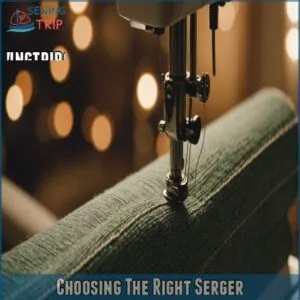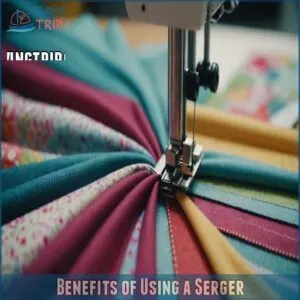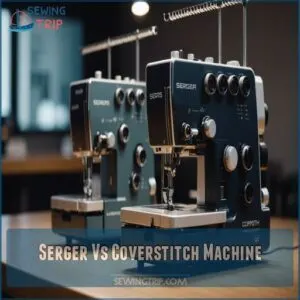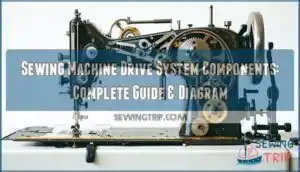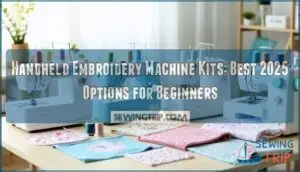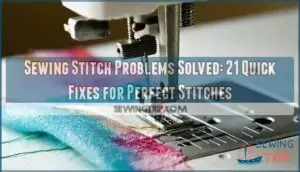This site is supported by our readers. We may earn a commission, at no cost to you, if you purchase through links.
 When you’re on the hunt for the best sergers reviewed, it’s as much about finding a trusty sidekick as it is about untangling threads.
When you’re on the hunt for the best sergers reviewed, it’s as much about finding a trusty sidekick as it is about untangling threads.
The Brother 1034D tops the charts, balancing load capacity with reliable performance.
Need a sturdy runner-up? The Brother Metal Frame Overlock DZ1234 is a strong contender.
For those budget-conscious moments, the Singer ProFinish 14CG754 won’t let you down.
Beginners can ease in with the Janome 8002D, while the Singer 14T968DC offers versatility for the more seasoned stitchers.
Want something portable? Try the Juki Mo600N.
Ready to unravel new sewing potentials? Keep reading for essential tips!
Table Of Contents
Key Takeaways
- You’ll find the Brother 1034D offers the best balance of reliability and performance, while the Singer ProFinish 14CG754 is perfect for budget-conscious choices.
- Consider your sewing experience and project frequency; beginners should aim for simplicity with models like the Janome 8002D, while experienced users need more features.
- Pay attention to the serger’s size, weight, material, and motor power to ensure it fits both your workspace and sewing needs effectively.
- Use sergers for their time-saving capabilities and professional finishes, especially on knit fabrics, as they handle edges and seams efficiently compared to standard sewing machines.
Choosing The Right Serger
When choosing the right serger, consider your sewing experience, purpose, and how often you’ll use it, as these factors influence your needs and satisfaction with the machine.
Also, think about the machine’s size, weight, material, and motor power to make sure it fits your workspace and project requirements.
Sewing Experience
Imagine this: you’re browsing serger reviews, keen to match your sewing experience.
For beginners, consider ease of use and a manageable learning curve.
A model like the Janome 8002D offers simplicity.
Experienced sewers, on the other hand, might crave serger features that tackle project complexity.
Whether you’re a novice or a pro, aligning skill level with machine capabilities is key.
Purpose and Frequency of Use
You’ve chosen your sewing style; now think about how often you’ll use your serger.
For professional use or frequent hobbyist sewing, a high-performance serger is perfect.
It fulfills voluminous project needs.
For beginner sewers, tackling occasional projects, simpler models might suffice, reducing complexity while cutting costs.
Carefully match serger types to your sewing rhythm, ensuring efficiency and satisfaction.
Size and Weight
Before you buy, consider serger size and weight.
Space requirements vary greatly; some are portable, ideal for limited space, while others demand a dedicated sewing area.
You can learn more about the variety of serger sizes and weights available by checking out this helpful resource.
Weight comparison is key—a heavier serger might feel more sturdy but less convenient.
Think about your workspace and sewing style to find the perfect fit.
Smaller sergers often have a smaller serger footprint, making them better for home use.
Consider stitch versatility and your needs.
Material and Motor Power
When looking for sergers, size matters, but material and motor power can make or break your experience.
Ever wonder why metal frames often outlast plastic ones?
It’s all in the durability.
High-torque motors guarantee your serger smoothly handles thick fabrics, affecting stitch length and width.
Choose wisely for a trusty companion that hums along with your sewing projects.
Key Features to Consider
When choosing a serger, you’ll want to focus on key features like thread options and stitch versatility, ease of threading, differential feed, and an automatic rolled hem.
These elements help your machine handle diverse fabrics efficiently and enhance your sewing projects with clean, professional finishes.
Thread Options and Stitch Versatility
When considering a serger, looking at models with color-coded threading like the Brother 1034DX serger review can be helpful. Selecting a serger often starts with identifying thread options and stitch versatility.
Explore serger stitch types, which range from classic overlock stitches to intricate rolled hem variations.
Thread count impacts stitch quality, ensuring durability and elegance.
Compare serger stitch options to coverstitch machines.
Striking the right balance enhances creativity and mastery over your sewing projects, making them uniquely yours.
Ease of Threading
Serging involves threading challenges, but you’re in luck.
Considering ease of threading lets you sew like a breeze without snarls or tangles.
When searching for the perfect serger, check out websites like top serger reviews for more information on the features.
Check these features:
- Color-coding simplifies the threading path.
- Air-jet threading automates and speeds up the process.
- Clear diagrams help avoid threading mistakes.
- Pre-threaded options eliminate hassle for beginners.
Enjoy smoother projects with these threading tips!
Differential Feed
Imagine this: you’re wrestling with fabric that seems more rebellious than your teen on a Sunday morning.
A serger’s ability to create durable overlock stitches, ideal for finishing seams and edges on stretchy fabrics and high-wear areas, is a game-changer for many sewing projects. A serger’s differential feed saves the day by taming gathers, preventing unwelcome fabric pulling.
Mastering the serger function, particularly with a Singer sewing machine serging, guarantees your sewing machine maintains stitch consistency, even on stretchy fabric.
So, in a serger review, differential feed isn’t just a feature—it’s your secret weapon for even feeding.
Automatic Rolled Hem
While differential feed adjusts fabric flow, the automatic rolled hem adds finesse, creating polished edges without breaking a sweat.
A serger with this feature lets you effortlessly achieve rolled hems on delicate fabrics.
It’s handy whether you’re crafting a wedding dress or hemming curtains.
Look for serger reviews highlighting this, promising the best rolled hems every time.
Benefits of Using a Serger
You’ll find that a serger greatly speeds up your sewing projects, creating professional-looking seams and reducing fabric waste by neatly finishing edges simultaneously.
Compared to a standard sewing machine, a serger offers superior results on knit fabrics and provides a more durable, less prone to fraying finish.
Time-Saving
Imagine streamlining your sewing projects with a serger machine, which can handle two to five threads simultaneously and create a durable and versatile overlock stitch. With the right serger, like the Brother 1034D serger model, you can kick off your sewing journey without draining your wallet.
Boasting impressive serger speed, these machines transform your workflow, slashing time on tasks like quick seams and faster hems.
With serger projects, you’ll realize the best sergers don’t just offer speed; they deliver time-saving tips in every stitch, especially when utilizing features like differential feed control.
Embrace the efficiency and watch your sewing tips flourish.
Professional Finish
When time’s tight, a serger becomes your trusty sidekick, transforming seams into perfection.
With every overlock stitch, expect a professional finish that no sewing machine can match.
Consider these benefits:
- Neat Seams – Prevent fraying effortlessly.
- Smooth Hems – Handle even tricky knit fabrics.
- Versatility – Switch easily between different fabrics. A quality overlock machine makes it simple.
Reduced Fabric Waste
A serger helps you cut down on fabric waste, especially when paired with upcycling tips for serger projects.
By trimming and finishing in one swoop, it turns fabric scraps into neat, eco-sewing triumphs.
With a serger, sustainable fashion becomes second nature.
Seek a model with easy serger threading, and don’t forget to check serger reviews for the best serger price and serger warranty options.
Versatility With Various Fabrics
Just as reducing fabric waste boosts efficiency, sergers offer versatility with various fabrics.
Whether it’s knit fabrics that require stretch or woven fabrics demanding precision, sergers handle both with ease.
Using specialized serger stitches, you can create seams perfect for any material.
This adaptability makes sergers indispensable, providing outcomes that typical sewing machines might struggle to achieve.
Serger Vs Coverstitch Machine
When deciding between a serger and a coverstitch machine, you need to understand their unique functions—sergers excel at finishing raw edges and creating strong seams, while coverstitch machines are perfect for hemming and add decorative stitches to projects.
Choosing the right machine depends on your sewing goals, whether it’s creating durable garments or adding professional hems and finishes.
Key Differences
You might wonder how a serger stacks up against a coverstitch machine.
They’re distinct in function:
- Stitch types: A serger stitches and trims, while a coverstitch is best for hems.
- Thread count: Sergers use 2-8 threads; coverstitch machines use fewer.
- Usability: Both enhance garment construction, affecting your sewing style.
When choosing between the two, considering the top coverstitch machines and their benefits can help you decide which one suits your needs.
Understanding these differences can streamline your projects!
Choosing Between a Serger and a Coverstitch Machine
So, how do you decide between a serger and a coverstitch machine?
Both enhance your sewing skills, but they excel in different areas.
Consider these key differences:
For a more in-depth comparison of sergers, you can check out a serger comparison guide.
| Feature | Serger | Coverstitch Machine |
|---|---|---|
| Stitch Type | Overlock, rolled hem, flatlock | Coverstitch, chainstitch |
| Primary Use | Finishing seams, neat edges | Professional-looking topstitching |
| Fabric Types | Knits, wovens | Knits, especially |
A serger’s speed and edge finishing are unmatched, while a coverstitch machine creates a beautiful, professional finish.
The best choice depends on your sewing priorities.
Uses for Each Machine
Exploring machine uses broadens your options.
A serger is fantastic for finishing edges, especially on knits and jeans, making them a workhorse in garment production.
- Serger: Ideal for stretchy fabrics.
- Coverstitch Machine: Perfect for hems and topstitching.
- Serger for Beginners: User-friendly models simplify learning.
- Serger for Projects: Offers versatility across sewing tasks.
Which Machine is Right for You
While both machines excel in specific tasks, deciding between a serger and a coverstitch machine often hinges on your project needs and budget.
A serger quickly wraps up edges and cuts seams, while a coverstitch machine perfects hems.
Check this out:
| Machine | Best For | Budget Range |
|---|---|---|
| Serger | Edging & Seaming | $250-$600 |
| Coverstitch | Hemming | $300-$700 |
| Combo | Both edging & hemming | $600-$1000 |
Considering serger reviews and user feedback aids in your choice.
Frequently Asked Questions (FAQs)
Which Serger machine is best?
Think of a serger as a tailor’s best friend.
The Brother 1034D shines as a top choice with its versatility, ease of use, and affordability.
Perfect for home sewing enthusiasts looking for reliability without breaking the bank.
Which Serger is best for beginners?
For beginners, the Janome 8002D Serger is excellent.
It’s compact, budget-friendly, and user-friendly.
This machine offers essential features like 3/4-thread stitches and color-coded threading, making it easy to learn serging without overwhelming complexity.
Is a serger a good sewing machine?
Did you know sergers stitch 1,100-1,500 stitches per minute?
A serger isn’t a sewing machine; it’s a specialized machine that creates professional finishes and is ideal for tasks like hemming pants efficiently. It’s a specialized machine.
It excels at finishing edges, creating professional-looking seams, especially on knits.
It’s a powerful addition, not a replacement.
Is a serger a good choice?
A serger is a stellar choice if you want to finish fabric edges professionally, achieve stretchy seams, or save time.
It complements a regular sewing machine, which can also be used to achieve a serged finish with an overlock sewing foot, offering speed and precision for projects demanding polished results.
Who makes the best serger?
Brother and Baby Lock stand out in serger manufacturing.
Brother offers versatile models like the 1034D, known for affordability and ease, while Baby Lock excels in performance with advanced features, making them favorites among sewing enthusiasts.
What is the easiest serger to use?
The Baby Lock Victory is the easiest serger for you to use, boasting powerful performance, user-friendly color-coded graphics, and tubular loopers that prevent threading errors.
It simplifies sewing tasks while ensuring a polished, professional finish.
What is the difference between a serger and an overlock serger?
A serger and an overlock serger are actually the same machine.
They’re both designed to trim fabric while sewing edges to prevent fraying.
It’s just two names for the same handy, time-saving sewing tool.
When to use a 3 or 4 thread serger?
Think of a 3 or 4 thread serger like a trusty sidekick in your sewing adventures.
Use a 3-thread for lighter crafts or simple edges and a 4-thread for strong, durable seams on heavier fabrics.
What are the maintenance tips for sergers?
Keep your serger in top shape by cleaning lint after each use, oiling moving parts monthly, and changing needles regularly.
Check tension settings, blade sharpness, and threading for smooth operation, ensuring long-lasting and efficient performance.
How do you troubleshoot common serger issues?
Troubleshooting serger problems is like detective work!
Check your threading, tension, and needle condition first.
Clean lint and oil moving parts.
If problems persist, consult your manual or a repair professional.
Can a serger handle denim or thick fabrics?
Absolutely, a serger can handle denim and other thick fabrics if equipped with a strong motor and adjustable pressure settings.
Look for models with high presser foot lifts and powerful knives to guarantee clean, smooth finishes.
What accessories enhance serger performance?
When sewing’s a breeze, additional serger attachments make all the difference.
Look for tweezers, various foot attachments, and a trim catcher.
A high presser foot lift enhances handling thick fabrics, maximizing your serger’s versatility and efficiency.
How long does a serger typically last?
Sergers can last 15 years or more with regular maintenance and gentle use.
A high-quality machine outlives cheaper models, especially if you clean lint, oil parts, and replace needles regularly.
Treat it well, and it rewards you.
Conclusion
Unravel the potential of sewing like a maestro with the best sergers reviewed here.
Picture a well-oiled machine that transforms fabric edges into seamless art.
Whether you’re a beginner with the Janome 8002D or a seasoned pro wielding the versatile Singer 14T968DC, each serger brings unique threads to the table.
From saving time to achieving that coveted professional finish, these top picks will tailor your creativity into reality, stitching together a tapestry of possibilities.

